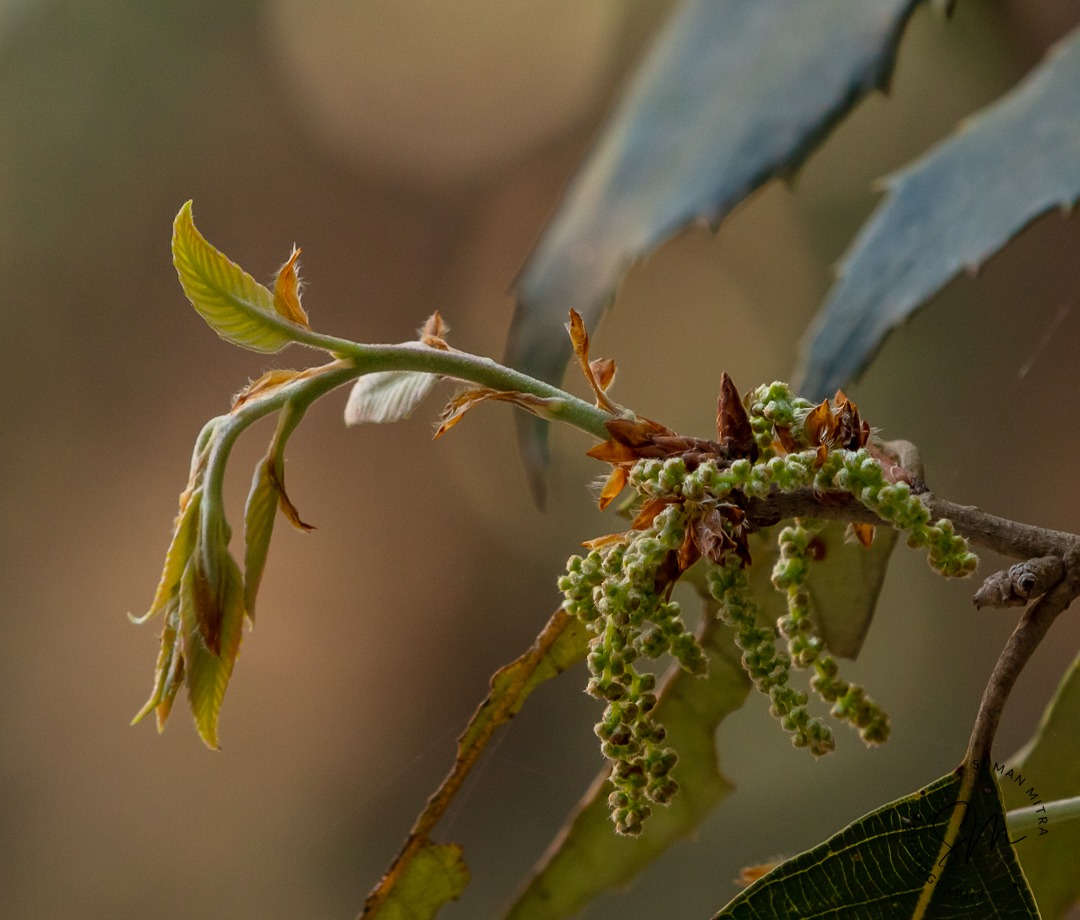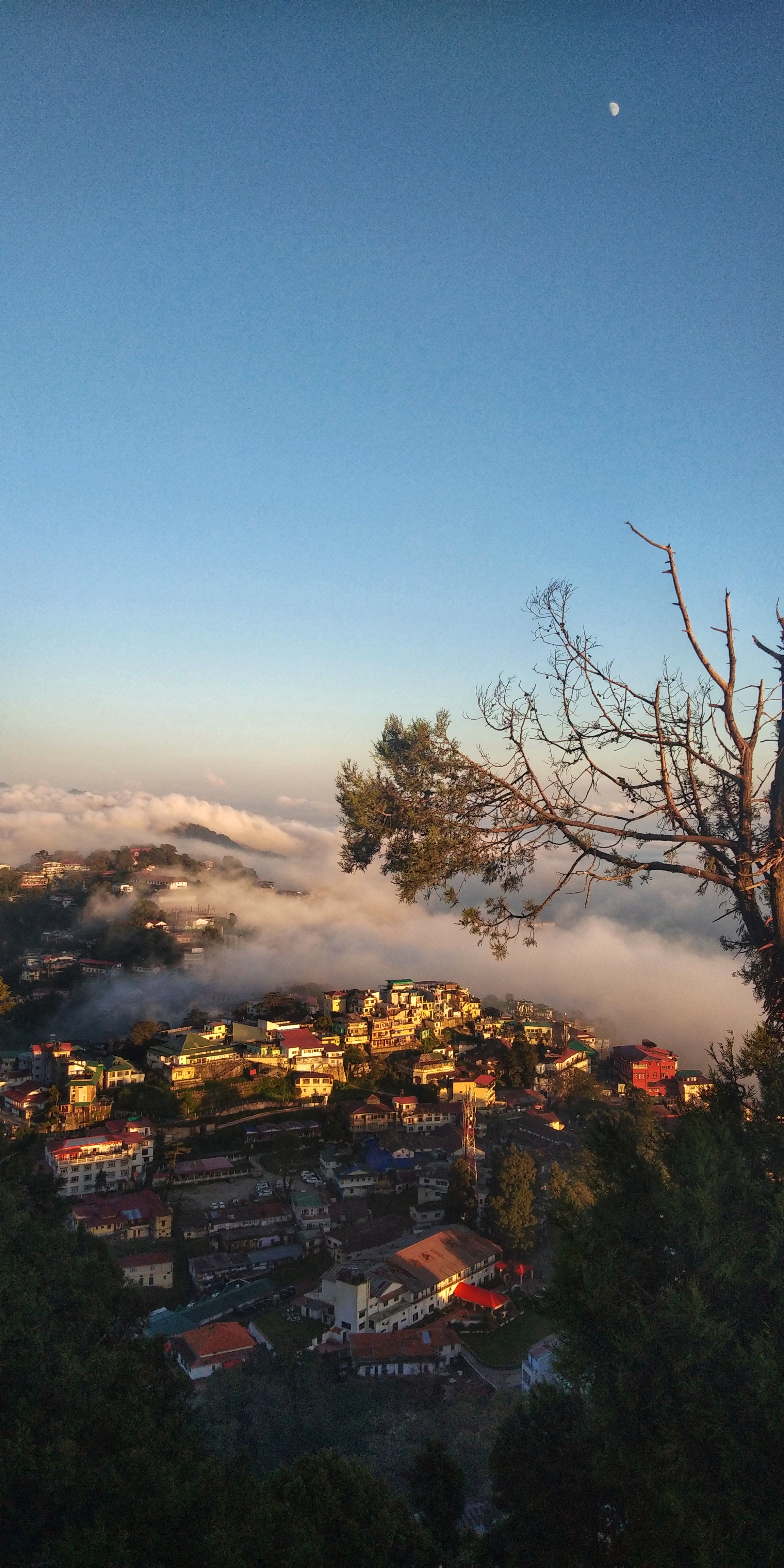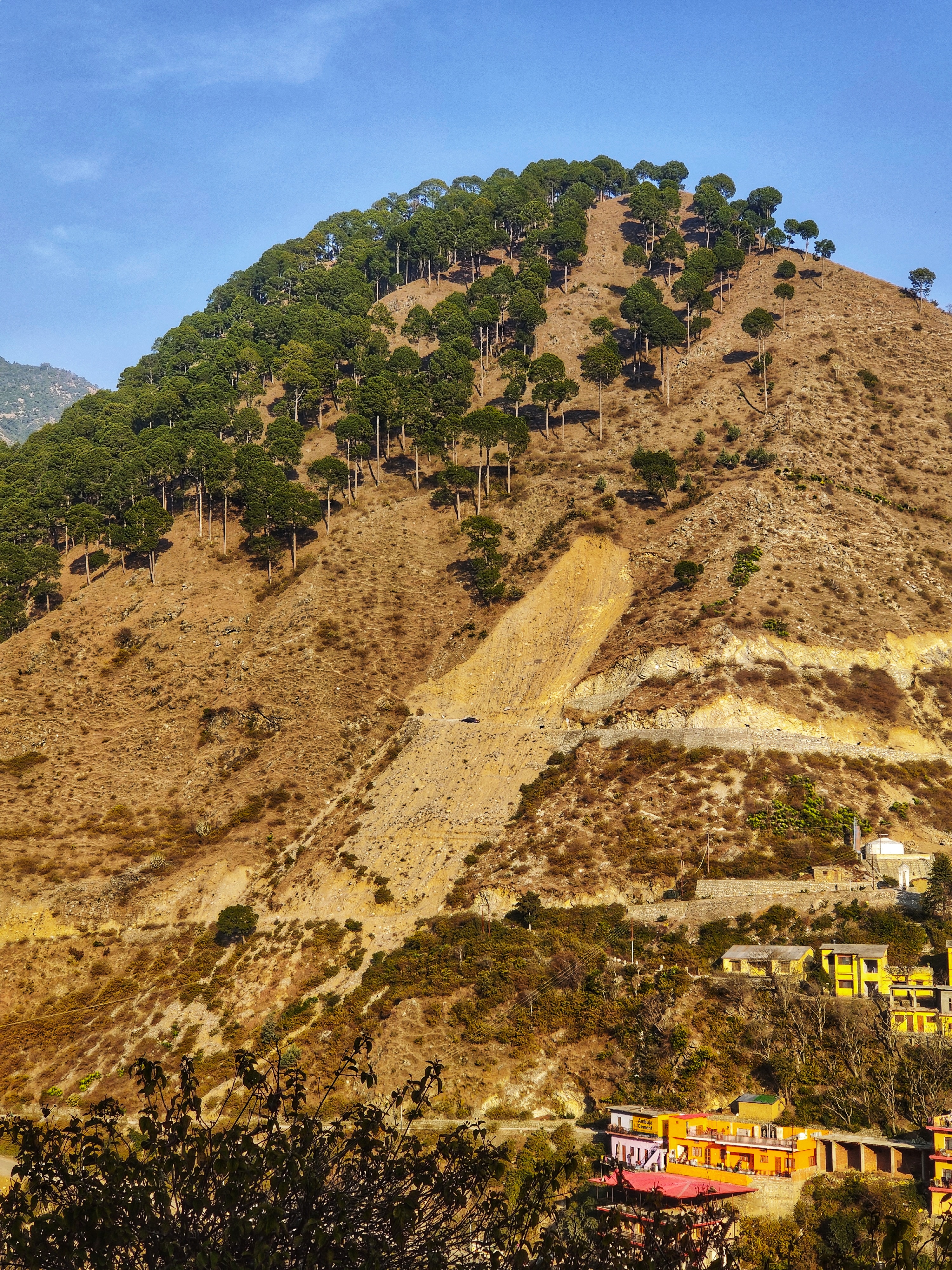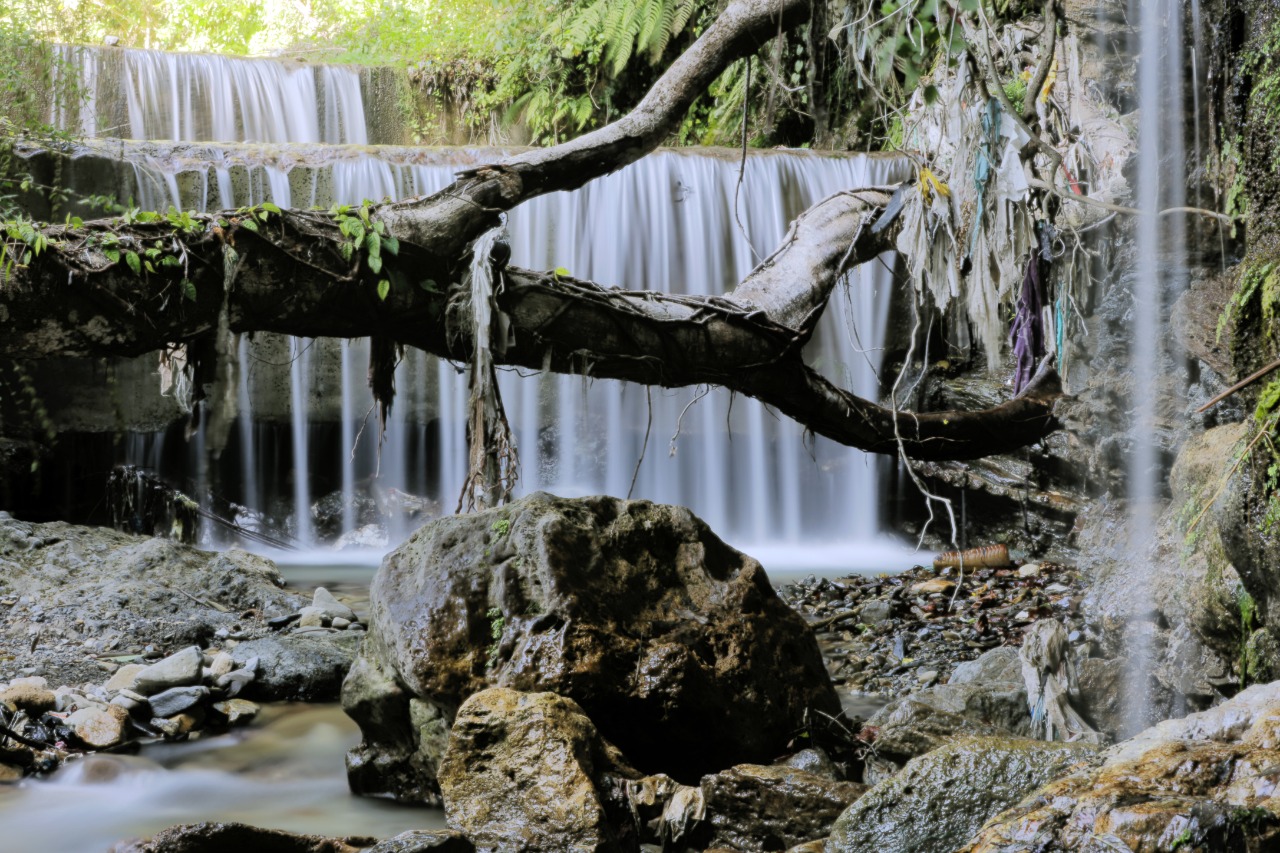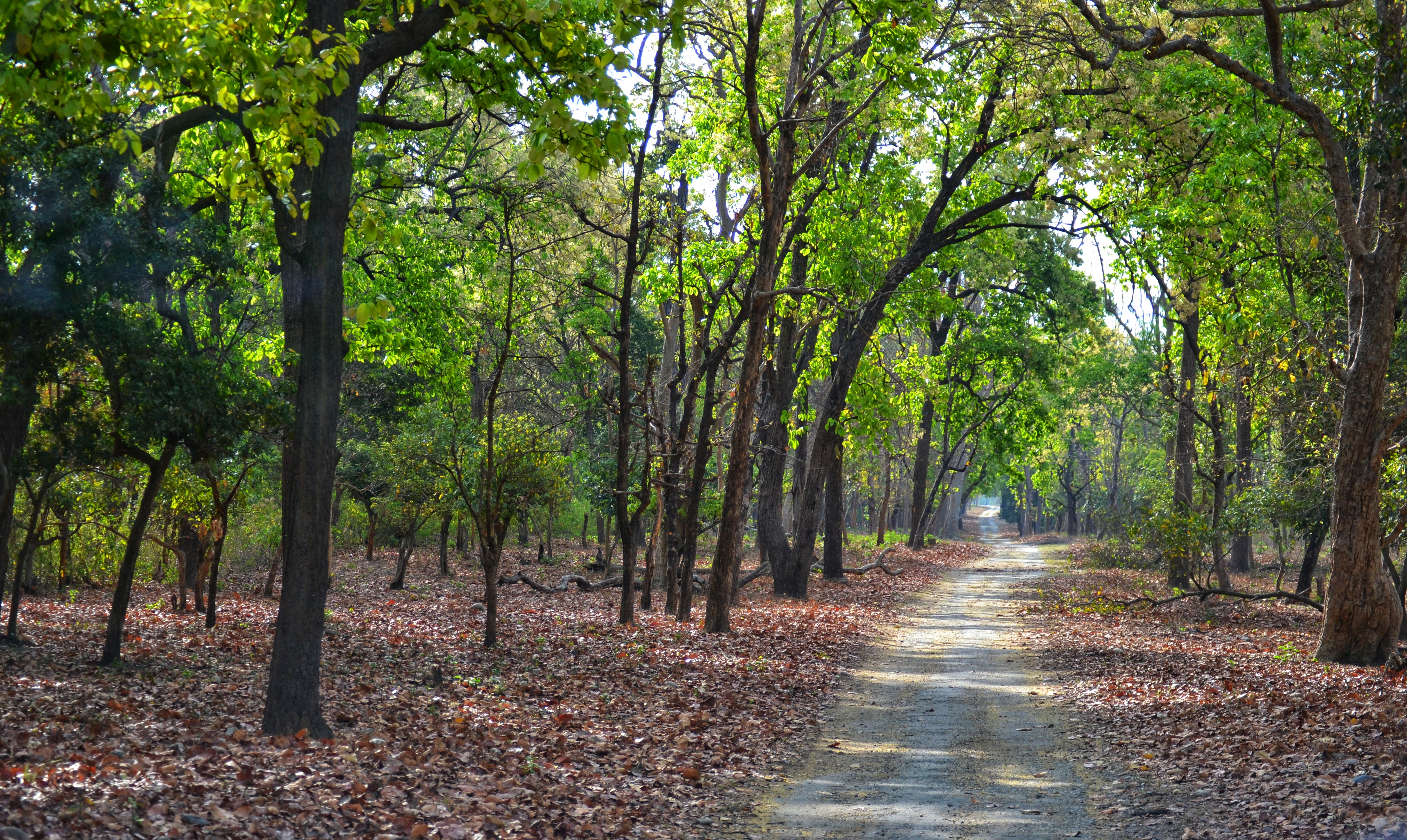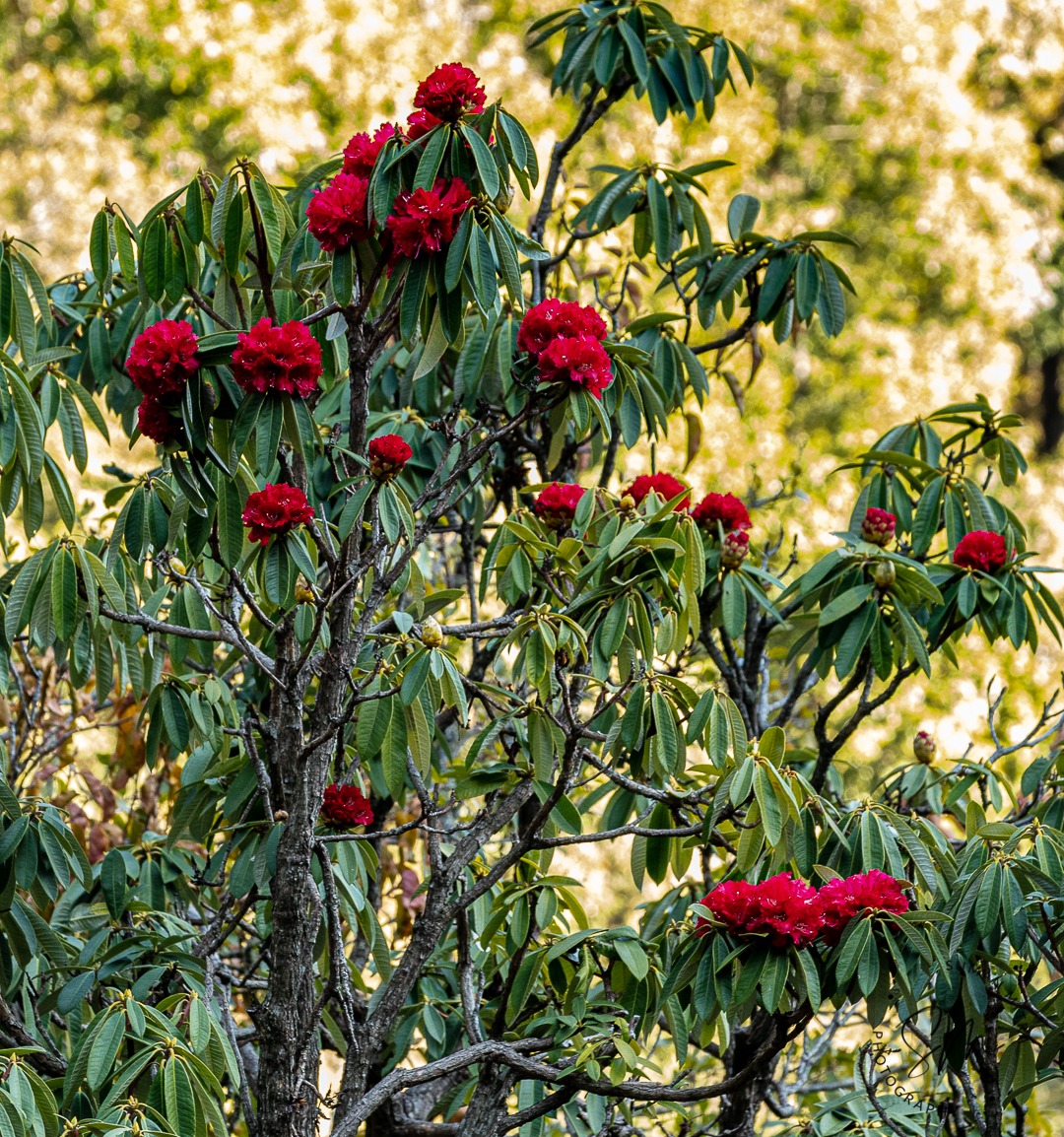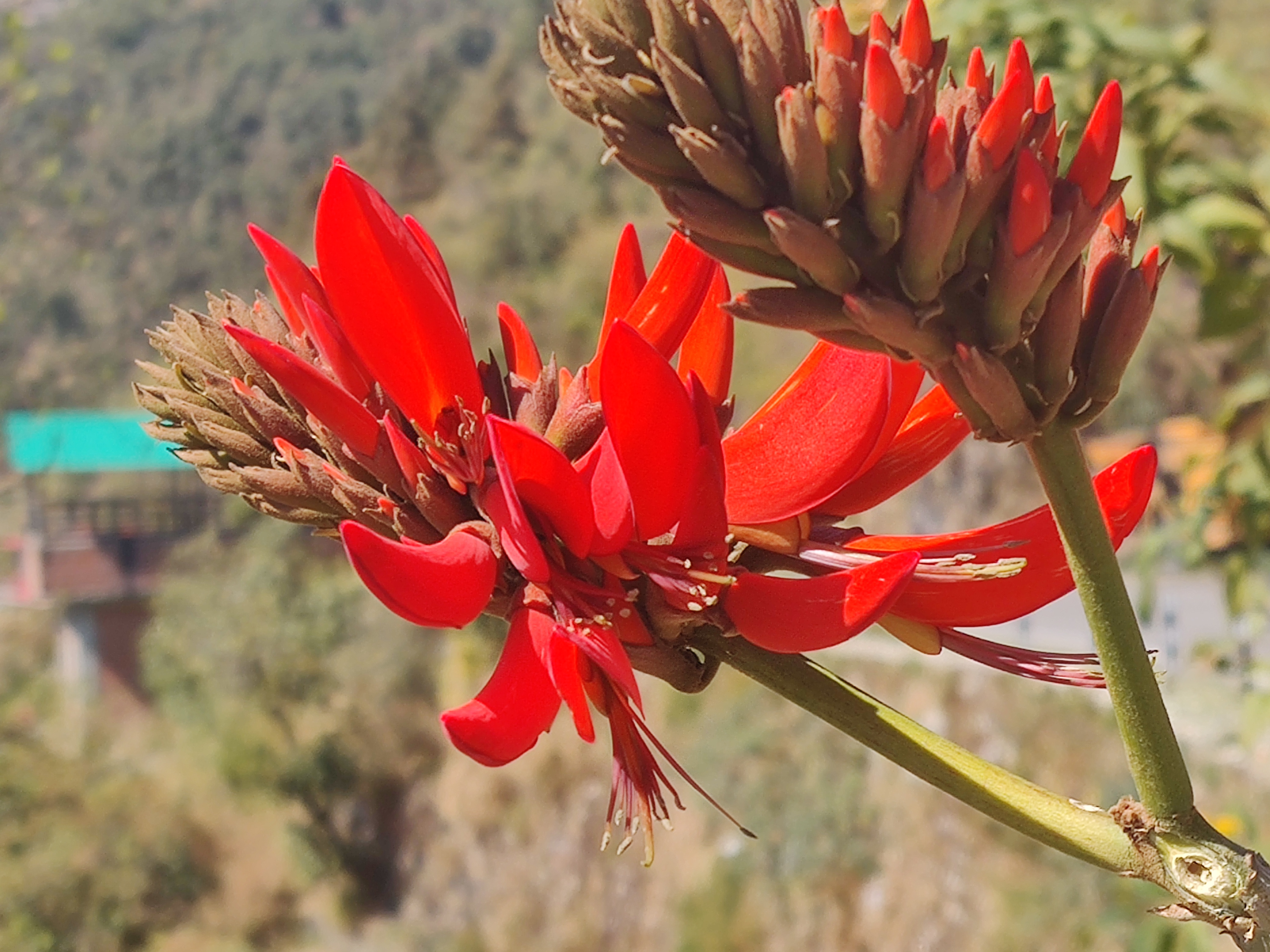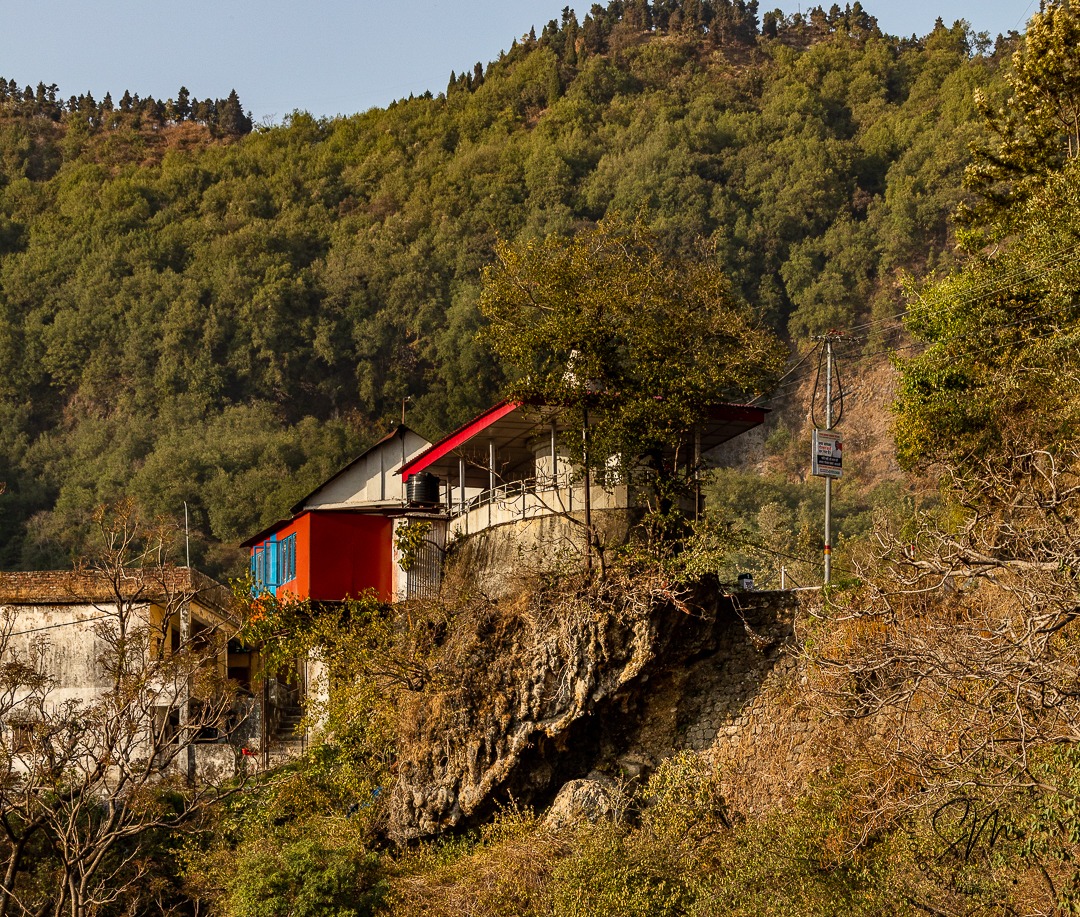The most simple defintion of ‘flower‘ is colourful part of the plant also resonates as something colourful, delicate, fragrant. But nature is full of exceptions, because there are some flowers in the nature which are neither bright nor colourful and some without fragrance yet they play significant role in sustaining the ecology of a particular area. One such flower is the flower of ‘Oak tree‘ (Quercus leucotrichophora) commonly known as ‘Banj Oak’. The Oak trees growing in the lesser Himalayan hillside of Landour, Mussoorie are in full bloom alongwith the onset of the spring season. Oak tree is a flowering tree species and they begin to bloom in the spring. The yellowish green flowers are mostly unnoticed because they appear like new unfurled leaves from a distance. After spending several months in cold winter and snow, the warm spring aids the blooming of flowers buds and leaves. The Oak trees are monoecious which means that both male (staminate) and female (pistillate) flowers are present on the same tree. The male flowers appear as strings of beads hanging (catkin) from newly developed branches. While the female flowers are somewhat hidden near the base of emerging leaves resembling as that of leaf buds and can viewed better under magnifying glasses. The male flowers produce pollen, while the female flowers produce eggs that will be fertilized once the flowers are pollinated. The pollens sometimes cause allergy during the blooming season. The flowers of Oak tree are mainly wind pollinated, although I have observed honey bees hovering on the Oak tree flowers. Also, I have observed sunbirds, blue whistling thrush, woodpeckers, Langoors and monkeys near new leaves (purplish brown colour) and flowers of the Oak trees. Proper studies should be done to have better understanding of pollination ecology and behaviour of Oak trees. These Oak trees welcome each day of mine with sweet Himalayan melodies of the birds and breeze. These Oak forests are home to different birds, butterflies and animals. With the onset of spring I observed something is very busy these days in the quieter side of the hillside of Landour. The nature’s visitors are becoming more frequent and curious to enjoy the beauty of the blooming flowers in the Oak trees. The Blue whistling thrush wishes pleasant good morning through its melodious song, the sunbirds hop from branches and leaf to lead sometimes get puzzled in themselves. The chorus of the cicadas are also distinctively audible these days. The Great Barbet often comes to sit on the top branches of the Oak trees and sings it’s loud, unmusical call to mark its presence. The jungle cacophony continues till dark when Mountain Scops Owl whistles to its tune. Beside birds, different varieties of butterflies and moths also do pay visit. The troop of Langoors and monkeys can often be seen relishing new leaves and acorns. Honey bees also hover around these freshly bloomed flowers. Oak trees are members of Beech family are beautiful and marvellous trees. Besides being an ecologically important tree species, they provide food and shelter to hundreds of varieties of insects and animals. They provide fodder, help in water and soil conservation, sequester carbon. But somehow, this tree is facing challenges in its natural habitat due to human made reasons.The rapid urbanisation and expansion of the Mussoorie and adjacent areas is paving way for ecological as well as habitat degradation and the adjacent forests and environment are facing challenges. Many foresters and researchers have found that there is high rate of mortatlity in some of Banj oak trees due to livestock grazing, lopping, extraction of fuelwood and various other biotic pressures. The mortality of this species is a matter of great concern which needs proper monitoring and research to find out the actual cause of the problem and also develop mitigation strategies to prevent the loss of the Himalayan legacy of Oak forests. Thank you!!! @chandrimadebi Picture courtesy https://www.facebook.com/SumanMitraPhotography https://www.sumanmitra.com/ All images and content are subjected to copyright © 2019 – 2021 chandrimadebi.com
Passive degradation of Himalayan ecology: Oak trees in Landour, Mussoorie
As soon as one enters the small hillside of Landour, Mussoorie; the old Oak trees, Pine trees and Deodar welcome everyone with open arms. The whistling Himalayan breeze blowing through the tree leaves endows life and hope in each and every corner of this beautiful hillside. With the changing seasons these evergreen trees always add charm and continue to succour the ecology, biodiversity. Besides, they also help towards conservation of soil and water. But during recent years I have observed deteriorated ecological condition of these beautiful trees in Landour and adjacent areas. While hiking in the area I have noticed various signs of disturbances, e.g. fire, lopping, removal of woody debris, human waste, and garbage including food wrappers, glass bottles and plastic bags. Today also I heard a nearby forest burning. The garbage dumping sites are alarming and must be properly managed, otherwise apart from risk to the ecology, might result in future forest fires in the adjacent areas if proper measures are not taken. The rapid urbanisation and expansion of the Mussoorie and adjacent areas is paving way for ecological as well as habitat degradation and the adjacent forests and environment are facing challenges. Alongwith the huge influx of tourists, garbage littering has always been a major issue in the hillside. But apart from the above mentioned issues, there is an important aspect which I like to draw attention through the article. The Oak, Pine and Deodar forests are also dying slow death due a botanical component also, climbers and vines. These climbers and vines slowly grow alongside trees and with the help of the hooks and suckers, they cause severe damage to the trees resulting often in the death of these mighty trees. The vines and climbers derive nutrition from the host tree and survives on it eventually it starts expanding its girth which ultimately leading to the death of the trees. Sometimes, these climbers form a thick blanket covering the roots and bark of the tree. During monsoons the leaves rots and fungal infections also results in the death of the tree. These climbers cause damage causing cankers or cracks eventually destroying large forest covers in the area. Hedera helix (common ivy), Vitis himalayan are the major vines, I have observed in Landour and vicinity areas which are actually speading fast and proper silvicultural operations must be adopted to control expansion of the species. I have witnessed such phenomena in Oak tree (Quercus leucotrichophora A. Camus) also locally known as Banj Oak or Himalayan Oak tree and Deodar (Cedrus deodara) trees. The Oak tree is a climax species in the region. Besides being significantly important to ecology, Banj Oak tree supports wide biodiversity. It provides fuelwood, fodder and timber and plays a vital role in conservation of soil from erosion and landslide, regulating water flow in watersheds and maintaining water quality in streams and rivers, and support high native floral and faunal diversity, thereby providing numerous ecosystem services to mankind in the region. Different parts of the plant such as seeds, leaves, fruit and dry gum resin is used to cure various ailments such as urinary infection, toothache, piles, diarrhea, asthma, hemorrhages, dysentery, astringent, diuretic, tonsillitis and snake bite, urinary tract infections. Many foresters and researchers have found that there is high rate of mortatlity in some of Banj oak trees due to livestock grazing, lopping, extraction of fuelwood and various other biotic pressures. The mortality of this species is a matter of great concern which needs proper monitoring and research to find out the actual cause of the problem and also develop mitigation strategies to prevent the loss of the Himalayan legacy of Oak forests.The vulnerable mountain ecosystems are prone to encounter greater risk of impacts, hence coordinated efforts are required to develop effective strategies for adaptation and mitigation. Thank you!!! @chandrimadebi Picture courtesy https://www.facebook.com/SumanMitraPhotography https://www.sumanmitra.com/ All images and content are subjected to copyright © 2019 – 2021 chandrimadebi.com
Shades of soil: soil paintings and art
We live in a colourful world, colourful skies, green forests, vivid shades of flowers, vibrant life forms, art and paintings, but have you ever observed the different palettes of soil beneath our feet. Often we overlook some crucial objects in our lives even if they lie in front of our eyes. The soil, supporter of lifeforms has multiple hues and shades alongwith with changing soil profile and topography. Being a student of geology and forestry, one is naturally inclined towards studying soil and formation and plant soil interactions. While studying and experimenting with soils, I was fascinated by the vivid hues and shades of soil. The changing gradation of colours in soil profile or a geological formations under forest cover. The leaching, calcification, weathering creating colorful shades. No sooner I came to know that the art of soil paintings dates back thousands of years ago. Around 40,000 years ago, artists invented first colours which was a combination of soil, animal fat, burnt charcoal, and limestone. The basic palette comprised of five colors mainly red, yellow, brown, black, and white. With the advancement in scientific technologies new colour pigments has accompanied advances in history of art and painting. Red Ochre, found in iron-rich soil was first used as an painting material in prehistoric cave paintings. Red ochre is one of the oldest colour pigments still in use.Soil colors serve as pigments in bricks, pottery and artwork. In different parts of the world, ancient cave paintings, pyramids, murals etc depict so much about the lifestyle during those days with the aid of soil colours as art medium. In India, many cave paintings dating back to 30,000 years has been discovered in Karnataka, Madhya Pradesh, Maharashtra, and Uttar Pradesh. While traveling lengths and breadths Indian subcontinent, one can come across varying soil types and colours and textures associated with them. From red soil in north east India to black cotton soils in the western parts. Ochre colored soils to whitish kaolin rich soils. With the changing altitude and mineral composition the colour varies. Many consider soil as abiotic, ie without life, but actually soil is a living body, which is formed under the combined effect of parent rock, topography, climate, vegetation and the time. The process of soil formation includes the combined effect of physical, chemical, biological and anthropogenic process on soil parent material and vegetation helps deciding soil characteristics. The weathering agents in nature react with the soil particles sometimes and provide distinct hues and palettes of soil. In order to study and classify soil types Munsell colour code is often used by scientists as well as artists. The study of soil and associated properties gives useful information to understand the possibility of utilizing the land for a particular use. Such studies become more important in fast eroding landforms like the Himalayas, the floodplains, deserts. There is limited knowledge and data of physical and chemical properties of soils and climatic conditions of different forest types. Therefore, sufficient theoretical and practical knowledge of various landforms and the complex relationship between the forests, soils and lifeforms need ample studies. The paintings with soil has art medium are not only eco-friendly but also economic as well as creative exploration.The Dutch painter Hieronymus Bosch (1450-1516) used earth and soils as the main subjects of his paintings to evoke deep religious symbolism and meaning. In the recent years, people are experimenting considering soil as artistic medium in the recent years, clay pottery, art of rangoli are to name a few. Healthy soil not only provide us food but also multiple tangible and intangible benefits. Colours blend with vegetation, sky, water, etc. The color and texture of soil painting is a fascinating creativity.why not use them as colour pigments for paintings. Thank you!!! @chandrimadebi Picture courtesy https://www.facebook.com/SumanMitraPhotography https://www.sumanmitra.com/©images and content are subjected to copyright © 2019 – 2021 chandrimadebi.com *https://www.google.com/search?q=cave+paintings+in+india&client **Shutterstock image ***https://soilhealth.cals.cornell.edu/about/soil-painting-2/
Precious water!!
World Water Day is held on 22 March every year since 1993 which focuses on the importance of freshwater. About 2.2 billion people are living without access to safe water, while the global sources of freshwaters are reducing at a rapid rate. With glacier shrinking, rivers drying and global climate change , it’s a nature’s alarm to take action before it’s too late. With these thoughts few words slipped out of my pen. Base of life;Or mere a molecule,Universal solvent are you,Water in the rivers, water in the bottles;So precious are you!! ***** Into the clouds, through the rain,You shower on mother earth;You reach the rivers and finally seas,Quench thirst and remove dearth. ***** In the icebergs and glaciers,You are frozen sinces ages;Regulating life cycles since prehistoric times,Your mention is in pages. ***** Life giver you are,We are primarily composed of you;You run through emotional eyes,And the hard worked muscles too. ***** Human beings with selfish needs,Continue to exploit you;Deforestation and climate change has, compelled to form drylands;And he keeps blaming you. ***** Artificial greens, artificial meat,Artificial intelligence and artificial we,lives artificial too ;We have found substitute for almost everything,But can we find substitute for you. It’s time to take action,To conserve, and value you;Or witness our Planet die,Long before our generations do!! ***** Thank you!!! @chandrimadebi Picture courtesy https://www.facebook.com/SumanMitraPhotography https://www.sumanmitra.com/ All images and content are subjected to copyright © 2019 – 2021 chandrimadebi.com
Tribute to the forests: International Day of Forests, 2021
The knowledge and conscience which we have gained today comes from nature, and primitive forests. Forests are the source of many mysteries and have played an significant role towards the evolution of mankind. If we look back into the evolutionary history of mankind, we will find that every aspect of adaptation and evolution of the primitive life and mankind has been inspired by the forests around. Forests play an important role from birth till death of a human life. They are the avenues which have clues to solve the greatest wonders. Forests are great teachers and through ages they have taught us humility and respect for each other and also towards the environment. They have inspired to inculcate healthy and happier approaches to lead life. Our brains have evolved in such a manner that even today one finds solace and tranquility in the arms of nature and pristine forests. People are now slowly transcending towards natural ways of living, to again connect with forests and nature, as they have realised the cacophony of the materialistic world can only provide fulfillment of selfish desires and leave one deserted, eliminating the sense of belongingness. Making unconditional bond with selfless nature and forests helps create oneness with mother Earth. These selfless forests, who can’t speak for themselves are somehow facing atrocities and wrath of selfish greed mankind. It’s a new normal to come across frequent news of forest fires, illegal mass deforestation, encroachment, poaching, tree felling for expansion of cities. Modern Forestry methods must improvise to combat such issues. While we are busy playing blame games, some wilderness is lost in some corner of Earth, which will take ages to replenish. Words of famous author Leo Tolstoy sometimes echo in my ears ‘How much land do a man need’? Ever since childhood, I experienced deep-rooted connection with nature, forest and wildlife. I recall, while traveling to my grandparent’s place during summer vacations, the train traversed through dense forests, vast agricultural fields, over the rivers, through the tunnels, into the valleys. I used to imagine what lied beyond these forests, is there a tiger lurking through the woods or herd of elephants silently waiting to cross the railway tracks, animals in the fields surpassing me, deers in the forest. I used to become wonderstruck and imagined who would have created these picturesque landscape and life with utmost pristine love and perfection. My encounters with diverse geologic terrains and the complex interaction of climate, soils and rocks, water, animals, (including insects and fungi) and plants as the defining elements of a natural forests inspired me to study Forestry. I learnt that forests are more than just a vast collection of trees. It is a natural, complex ecosystem, made up of a wide variety of trees, that support a considerable range of life forms. Forests and biodiversity are key to all life forms.The rich diversity of life, has immense opportunity for medical discoveries, economic development and adaptive responses. But to my dismay I realized that millions of hectares of forest is destroyed every year to cater and suffice the ever-increasing selfish and merciless needs of the human population. Present day forests are facing massive degradation. There is decline in the richness and health of the existing forests. Illegal and unsustainable logging and mining, over-harvesting of wood, small-scale farming, hunting, forest fires, and pests and diseases are threat to the present day forests. The ever-increasing demand of human being risked the survival of countless species, jeopardized people’s livelihoods and undermined the vital services that forests provide has posed threat not only to the nature and wildlife but also to the basic humanity and mankind. Now, when I peep into my memories and try to relate with present earth, I only search for those everlasting moments of happiness, fulfillment and accomplishments which I used to derive from the forests, nature and wildlife during childhood. I return back to reality in despair and the melancholy just to find that how almighty’s ultimate creation ‘Human Beings’ are responsible for the destruction and devastation of almighty’s creation. The International Day of Forests was established on the 21st day of March, by resolution of the United Nations General Assembly. As we celebrate World Forestry Day, we express our deep gratitude and thankfulness towards Forests. I came across these lines in Silent Valley National Park, Kerala, truly inspiring The shade of each leafThe moisture onEach grain of sandEvery little hill foldThat you seeGives to the riverThat flows into the landmassesGives life to all our landsConserve Nature Happy World Forestry Day!! Thank you!!! @chandrimadebi Picture courtesy https://www.facebook.com/SumanMitraPhotography https://www.sumanmitra.com/ All images and content are subjected to copyright © 2019 – 2021 chandrimadebi.com
Tree of Midnight Horror: Oroxylum indicum
It was one fine evening, I was taking a brisk walk amidst forest fringe village of a remote district of Assam, India. The weather was pleasant and I could feel the cold breeze coming from the mighty river Brahmaputra, which can be seen from a distance. Through the lush green fields, I could see some trees in the vicinity. Oh! It’s a Broken Bone tree, I was filled with excitement. It was for the first time I saw the ‘Tree of Midnight Horror’ also known as ‘Broken Bones tree’ or ‘Tree of Damocles’, scientifically known as ‘Oroxylum indicum’ in its natural habitat. There are various beliefs and thoughts associated with this particular tree. Some say that, during dark nights when there is thunderstorm and lightning bolt, the tree casts horrifying images, and so the name ‘Tree of Midnight Horror’. While others say that, the large leaf stalks wither and fall off the tree and collect near the base of the trunk, appearing to look like a pile of broken limb bones, hence also known as ‘Broken Bone’ tree. The long fruits curve downward and resemble the wings of a large bird or dangling sickles or swords in the night, resembling “sword of Damocles”. In India its also known as ‘Bhootvriksh’ which literally means ‘Ghost tree’. This tree is also planted in different parts of the world as an ornamental tree species, for it’s peculiar appearance. I found a small pathway leading to the tree and to my astonishment, no sooner I reached the tree, one of the dangling pods burst opened with white papery seeds fluttering like butterflies gliding with the wind and dispersed long distance. I was wondering with amazement as if the tree welcomed me. The tree has thin papery seeds which are creamish white in colour and are also known ‘Muhudie’, or the tree butterfly (mu means tree; hudie means butterfly). As a token I collected few seeds and the long pods of the tree. Oroxylum indicum has its mention in many ancient texts. In Buddhism, this tree has special mention. The tree bears fruits in the form of long flattened pods which bears many flattened papery seeds arranged in flaky sheets which are used during rituals as an offering to gods. The flowers of the tree has typical smell as that of raw papaya and are pollinated by bats. The tribals and rural people in Assam believe that pods hung on kitchen walls or near dining area help prevent choking while eating food in elderly people. This night blooming tree has immense medicinal value. The plant has anti-cancer, anti-tumour and antimicrobial properties. It is believed to be prescribed to treat toothache, rheumatism, wound, splenomegaly, gastralgia, dysentery, cholera, loss of appetite and fever. Besides, the decoction of the bark is known to cure gastric ulcer, mouth cancer, scabies and other skin diseases. The paste in the neck and throat area for quick relief of tonsil pain, and it is also applied on the wounds of animals to kill maggots. The long pods are used to kill crabs in paddy fields. But, for some reasons, this tree is endangered, vulnerable and threatened in different parts of Indian subcontinent. The sun was slowly setting down and I hurried my steps back through the paddy fields. Ofcourse I collected some seeds and pods of this mysterious tree. The moist and humid air was filled with the smell of leaves and grasses composting and frogs croaking in the marshy waters.The vast open paddy fields with lush green cover, some egrets and kingfishers waiting patiently to catch fish. I once again looked back at the tree and made my way back home. Destiny has its own course, who would have known that in future I will complete my doctoral research thesis based on this particular tree species. Thank you!!! https://chandrimadebi.com2020/12/14/oroxylum-indicum-a-medicinal-forest-tree-species-for-the-symptom-management-of-covid-19/ @chandrimadebi Picture courtesy https://www.facebook.com/SumanMitraPhotography https://www.sumanmitra.com/ All images and content are subjected to copyright © 2019 – 2021 chandrimadebi.com
Phool Dei: Celebrating nature and mankind
Here comes the spring and season of flowering has already begun in the beautiful state of Devbhoomi, Uttarakhand also known as the ‘Land of Gods‘. This marks the celebration of a folk festival in different parts of Uttarakhand, ‘Phool Dei‘. Phool means flower and ‘Dei’ is a ceremonial dish prepared on this occasion. After long winters when the Himalayan snow slowly recedes away, the people of Uttarakhand celebrate the year’s harvest along with arrival of spring and seasonal blooming of Rhododendrons (Burans). Rhododendron is also the state tree of Uttarakhand. Trees blossoming with vivid shades of red, yellow, white and pink in the forests. Rhododendrons (known as burans locally) and Reinwardtia sp.(phyuli), Kachnar (Bauhinia sp.) and many more. Phool Dei festival celebrates the close knit relationship between man and nature. This festival is most enjoyed in the Himalayan villages where little children, specially young girls collect season’s first flowers of Phyunli, Buras and Basing from the forests. Later they keep the freshly collected flowers in ringaal (bamboo species) basket alongwith green leaves, jaggery, coconut to visit and greet people of the village. The children visit each house of the village and keep first flowers of the season on the doorsteps to bring good luck and blessings to the family and wish ‘Phool Dei’. Children are offered sweets and blessings for their act. But the true essence of Phool Dei is slowly fading away with rapid urbanisation and globalisation where human being has transitioned and so his cultural and traditional values. In search of better livelihood opportunities rural people are migrating to cities and so the values, traditional knowledge are also migrating. While we are busy celebrating major festivals, we have little importance to the age old traditional festivals like Phool Dei which celebrates the relationship between nature and mankind. Infact many folk festivals are slowly getting lost in the pages of history. To commemorate this occasion, every year Annual spring festival is celebrated in Rajbhavan, Dehradun. Uttarakhand is rich in biodiversity of flowering plants. Efforts must be taken to promote lesser known wild forest flowers and ornamentals to pave way into the market, so as to boost horticultural and forestry market. Efforts must be taken to familiarise and celebrate these festivals which focus on values and traditional customs before they are long lost in memories. Folk festivals acknowledge the values of the intricate relationship between mankind and forests and nature. Thank you!!! https://chandrimadebi.com2021/02/13/rhododendrons-and-a-tale-of-love/ @chandrimadebi Picture courtesy*downloaded from website https://www.facebook.com/SumanMitraPhotography https://www.sumanmitra.com/ All images and content are subjected to copyright © 2019 – 2021 chandrimadebi.com
Landour skies !!!
Landour, named after the Welsh town ‘Llanddowror‘ is home to mighty oaks, pines, cedars and rhododendrons. Every nook every corner of this small hillside is blessed with pristine serenity and beauty. Even the skies above Landour too don’t fail to mesmerize along with the changing seasons. The skies over Landour, always astound one with the clouds changing forms and shapes with different seasons, as if almighty has set spectacular screensaver in the high skies. Be it cumulus, cirrus, cirrocumulus or cirrostratus, these beautiful clouds over Landour skies can arouse artistic aspirations in a creative corners of mind. These clouds sometimes play hide and seek between manifold layers of mountains, they rise up go down swirling along the curves, edges in the valley as if they are dancing alongwith the wind. These clouds often march into the valley like a troop and suddenly recede away, slowly fading into the clear evening breeze. Be it dawn or the dusk, skies in Landour create picturesque panorama along every nook and corner of the hillside. The famous winterline is also visible from Landour and displays striking clear view in the evening, inspiring nature lovers and photographers all over. The northern breeze sometimes carries these clouds through the pine and oak forests creating a mystic bluish haze which can sweep someone away off their feet. Sunlight entering through the mist in the Pine forest can make one spellbound as if almighty is pouring in rays of hope from the heavens. Atmospheric clouds sometimes create illusion while driving over high mountain roads and at times can disappoint nature lovers who love watching snow cladded high mountain peaks. The clouds can suddenly lift their veils and can make one wonderstruck with the majestic view of the snow-covered Himalayas. Altogether the mountainous topography, natural landscape, altitude, meteorological phenomena altogether contribute towards the incredibly amazing canvas of the beautiful Landour skies. For once in lifetime please visit the beautiful hillside of Landour. I will conclude with the lines of the poem ‘The Cloud’ by Percy B. Shelly I bear light shade for the leaves when laidIn their noonday dreams.From my wings are shaken the dews that wakenThe sweet buds every one,When rocked to rest on their mother’s breast,As she dances about the sun.I wield the flail of the lashing hail,And whiten the green plains under,And then again I dissolve it in rain,And laugh as I pass in thunder……. Thank you!!! @chandrimadebi Picture courtesy https://www.facebook.com/SumanMitraPhotography https://www.sumanmitra.com/ All images and content are subjected to copyright © 2019 – 2021 chandrimadebi.com
Red Coral Tree Flowers !!!
Up in the mountains,I was missing the sea;The clear blue waters,And the red corals beneath. ***** But thank you O lord!!For showing me;the clear blue sky,And I barely miss the sea. ***** Thank you O lord!!For the red Coral Tree flowers,High above in the mountains;Now I barely miss the red corals in the sea. ***** Red coral flowers, I know you will fade,With the days passing by;But I thank you for filling the void,Of the blue waters and corals red beneath. ***** Thank you!!! @chandrimadebi Picture courtesy https://www.facebook.com/SumanMitraPhotography https://www.sumanmitra.com/ All images and content are subjected to copyright © 2019 – 2021 chandrimadebi.com
Nature’s bulwark: Bhimal tree (Grewia optiva) securing a temple, Mussoorie!!!
It was one sunny morning, while I was travelling to Dehradun via Mussoorie – Dehradun road and I was lost in the scenic beauty of the mountains. Every turn, every bend around the mountain road has its own surprise. Suddenly, just after crossing Kolhukhet checkpost my eyes fell on a small temple on the hill slope secured by ‘Bhimal’ tree roots. The temple on the hilly roadside was constructed on a boulder and the very foundation of which was supported / bulwarked by a Bhimal tree (Grewia optiva). I was intimidated by the sight, because it appeared to be geologically unstable. The temple belongs to Goddess Durga, and the history of the temple can be traced back to the times when India was under British rule. During those times, Mussoorie – Dehradun road was a forest path and the hills were covered with thick forests with rich biodiversity of flora and fauna. People usually travelled by foot walking long distances and took rest under the shadow of the trees. Various water streams and rich biodiversity of flora and fauna flourished during those days. I thought, may be the forest dwellers constructed this temple to protect and safeguard of the commuters and travellers. I was eager to know when the temple was constructed and enquired the adjacent tea stall owner. He said that the temple was established long back while the construction of Mussoorie – Dehradun road was underway. A Bhimal tree was standing alongside the temple. I observed that over the time, the tree roots have slowly penetrated the rock foundation over which the temple was made. The entire structure is now showcasing an example of biological weathering. I was surprised by the sight, how the temple is still holding on to it’s very foundation till today, as if nature wants the temple to be there. It’s an usual sight to find Goddess or Shakti temples along roadside before entering major townships. I have also observed different temples alongside major highways before entering many cities. For instance famous Daat Kali temple (mandir) before entering Dehradun via Rajaji National park, a famous temple before entering Jorhat township (Assam) via Kaziranga National Park and many more. In other places, I have seen temples of Lord Ganesha, Shiva and Hanuman. It’s a belief that the presence of Gods and Goddess will avert accidents and disasters and ensure successful journey ahead. These temples are surrounded by age old trees and thickets making the place naturally serene, mystic and spiritual. During my field study and travels I have come across many temples, dargahs and other religious places where Peepal tree (Ficus religiosa), Bargad tree (Ficus benghalensis L.), Neem tree (Azadirachta indica) etc. grow in the premises, but I have rarely come across a temple site where an entire temple construction is upheld and bulwarked by a Bhimal tree. Bhimal tree (Grewia optiva) also known as bheku, beul or ‘todana’ in sanskrit is a medium sized deciduous tree species. This forest tree species has multipurpose medicinal and economic value. It is found up to altitude of 1800-2000 m in the north-west Himalayas. The tree has high endurance and can survive Himalayan frosts. It prefers growing on sandy loam soil with adequate moisture but habitation ecology varies too. Also, it’s an important forage tree species providing leaf fodder, fibre, and fuelwood. In Uttarakhand, besides Oak, it is one of the most preferred species to feed cattle. The wood is used in making various machinary tools.The fibrous woody material is used to make ropes, handicrafts and high quality paper. The branches of the tree were used as torches and firewood since earlier times. In agro-forestry systems in western Himalaya, Bhimal tree is a preferred species intercropped alongwith horticultural crops like taro (Colocasia esculenta) and turmeric (Curcuma longa) etc. But, despite its importance I have come across very few Bhimal trees growing in natural habitat in Uttarakhand. It is a matter of grave concern that once fully flourished tree has now a very restricted population, specially in the urban areas due to urbanisation and expansion of cities. The Bhimal trees are now mainly restricted to rural areas, where people have limited knowledge about the multiple benefits of the tree. Slowly, the traditional knowledge of the trees and their associated properties are fading away as we are depending more and more on the commercially available products and relying on unsustainable ways of living. Mussoorie – Dehradun road is a scenic delight and one can’t keep their eyes off the marvellous display of multitude coloured flowers on trees, herbs and shrubs and of course birds. But, this roadway is also prone to landslides and heavy traffic. I have witnessed many roadside constructions being washed away due to heavy rainfall and landslides. The Bhimal tree securing the temple is an exquisite example how trees and forests prevent erosion, mass wasting and anchor lithological features. It’s an age old saying that old trees sometimes have spiritual values attached with them. The Bhimal tree bulwarking the temple is either a nature’s miracle or trees are the actual protectors of religious faith. Thank you!! @chandrimadebi Picture courtesy https://www.facebook.com/SumanMitraPhotography https://www.sumanmitra.com/copyright @sumanmitraphotography All images and content are subjected to copyright © 2019 – 2021 chandrimadebi.com

